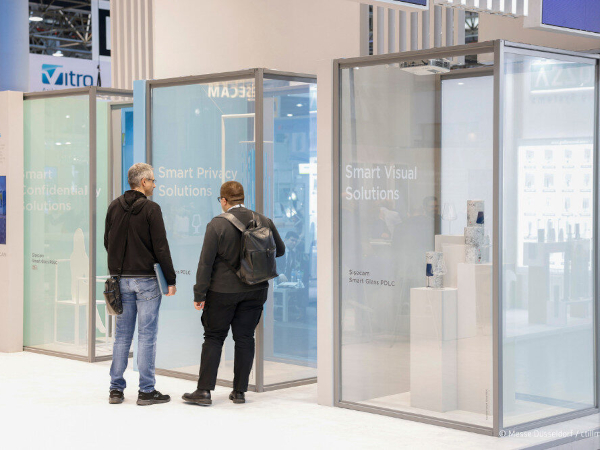Natural daylight supports our circadian rhythm, keeps us alert and productive. This is why humans prefer living and working spaces that are flooded with natural light. However, in a changing climate buildings need also more air-conditioning due to longer and more intense periods of heat. The glass industry offers solutions in the form of highly selective layered systems that make for both high daylight transmission and thermal protection in summer, which reduces the climatic load and the periods of time where shading is required. This can, however, be just one component of many for rising to the growing challenges of climate change. The approaches proposed by planners and architects for adapting to climate change will be discussed at glasstec 2024 (22-25 October, Düsseldorf) at its Architecture Forum. To shed some light on this topic beforehand, the author contacted the German Sustainable Building Council (Deutsche Gesellschaft für Nachhaltiges Bauen – DGNB) and renowned planner Arup on the trade fair’s behalf.
2023 was by far the hottest year since weather records began, reported the World Organisation for Metrology (WMO) in its current climate report: the globally averaged mean temperature was around 1.45 degrees above pre-industrialisation levels. The European Union’s Earth Observation Programme Copernicus recorded global warming of 1.48 degrees. While climate researchers rightly sound red alert due to accelerating climate change, it is clear it will get much hotter in many cities in future, especially in urban heat spots. These are urban zones where thermal island effects occur and temperatures rise well above those in surrounding rural areas. It is imperative that urban areas and their development are adapted to changing requirements and sustainable solutions are found.
Climate change adaptation as a multi-disciplinary cross-sectoral task
“Climate change adaptation” is also a relatively new discipline for the German Sustainable Building Council (DGNB), which is reflected in the current dynamism in relevant legislation from the EU to federal state levels. Eva-Maria Stumpp from DGNB’s research and development department explains: “We see a multi-disciplinary, cross-sectoral task here that involves architectural and engineering sciences but also biology, sociology, medicine and other disciplines and which has strong societal and participatory aspects.” Where cities, districts, buildings or even only parts of buildings are planned, the DGNB works at the interface between various disciplines and requirements from practice, and in a currently highly dynamic legal framework.
“Especially in view of heat and drought, precipitation and floods we try to develop proven effective, practicable and climate-protecting approaches that lead to even better buildings in future. The good news is: at least for Germany it can be said that carefully planned buildings in compliance with regulations are already very well positioned for both current and future climatic challenges on account of its high building standards and safety requirements. After all, the protection against environmental and weather influences has always been a core aspect of erecting buildings and settlements,” explains Stumpp.

Photo: Arup
A contribution to this has also long come care of the flat glass industry, whose portfolio is very well “equipped” for controlling energy and daylight levels. Leading manufacturers, for example, offer highly selective solar control glass, which reflects most of the heat-generating infrared rays of sunlight while transmitting most of the visible spectrum of daylight into the room. This means the climatic load can be reduced through the façade and shading in summer can be limited to shorter periods of the day.
“Closed cavity façades” with internal sun shading or electrochromic glazing can optimise light and energy levels in meaningful ways. In the wake of intensifying climate change, however, further measures will be required to keep cities viable, functional and prosperous – otherwise there is a risk of weather-related deaths, e.g. due to prolonged heat waves, and economic losses due to climate-related extremes. These adaptations are often a localised process taking local geographic, climatic, socio-demographic and economic factors into consideration. S
tumpp explains: “Passive and nature-based no-regret solutions still hold potential not sufficiently exploited.” She adds: “Short and medium-term climate adaptation measures must be implemented without compromising long-term climate protection goals.” Often, “infrastructural greening” is a solution to “repair” the cityscape and achieve measurable improvements for the urban climate, as numerous studies prove. This has also been understood by rating agencies that increasingly reward cities willing to change if they promote biodiversity and create new green spaces, for example. These measures have a positive impact on the climate, micro-climate and quality of life, as well as on lending and the provision of public funds.
Glass architecture and infrastructural green
Where greenery spreads in parks, backyards and front gardens and also “conquers” façades and roofs, it makes for evaporative cooling and shading thereby reducing local temperatures. Greening is therefore an effective tool for architectural and urban planning, says a convinced Rudi Scheuermann, who heads the “Cities Business” at Arup in Germany with a focus on the design of sustainable and resilient cities.
Arup, which has been operating on the German market for some 30 years now, is one of the major multi-national planners for high-performance buildings and infrastructure; in addition, they have committed to the United Nations’ 17 Sustainable Developments Goals. Scheuermann sees buildings holistically: insulation, ventilation, materials, connections etc. and he advocates the integration of plants in façades and roof greening. “By having plants in the surrounding space, in the façade and on roofs, the thermal mass can be shaded better during the day and at night this promotes cooling down. In addition, plants filter the fine dust and bind CO2, so that natural ventilation is possible and makes sense near them.
An important factor especially in cities is that they have a sound-dampening effect and reduce “stress levels”. Regarding façade and roof greening Scheuermann sees clear advantages for the building concept: “Plants on the roof provide evaporative cooling, shading and a noticeable reduction of temperatures; this is why air-conditioning systems on green roofs can draw in cooler air and be downsized from the outset – the building’s energy requirements as well as CO2-emissions are lower in operation.
Buildings with green façades and roofs require a little more steel for construction because of the higher wind loads and a well-planned drainage system. As a rule, rain and the grey water produced in daily operation are sufficient for the complete irrigation. It is essential to select plants according to region and microclimate so that they can withstand the local climatic influences all year round and can be cultivated by the local insects. Subsequently, it has proven to be a good idea to ‘just let the plants do their thing’ and not restrict their growth too much.”

Photo: Arup
“Climate change adaptation” is one of the Hot Topics at this year’s glasstec, the leading international trade fair for the glass industry, and will also be discussed at the Architecture Forum of the trade fair in October 2024.
Read the original aricle HERE.
About the author:

Marc Everling studied media education at the Technical University Brunswick, worked as a consultant in PR and marketing agencies for 14 years, and as Head of Marketing at one of the global flat glass players for six years. In February 2021 he founded his networking agency specialised in communications consulting and press liaison for construction material producers, initiatives, associations, trade fairs and architects which work and produce sustainably in the interests of the ecological transformation of the construction sector. Photo: Marc Everling Nachhaltige Kommunikation

















